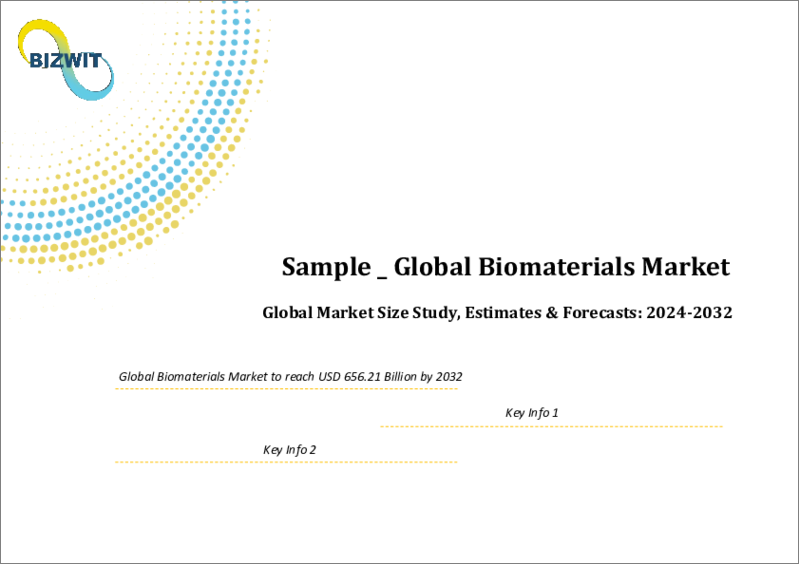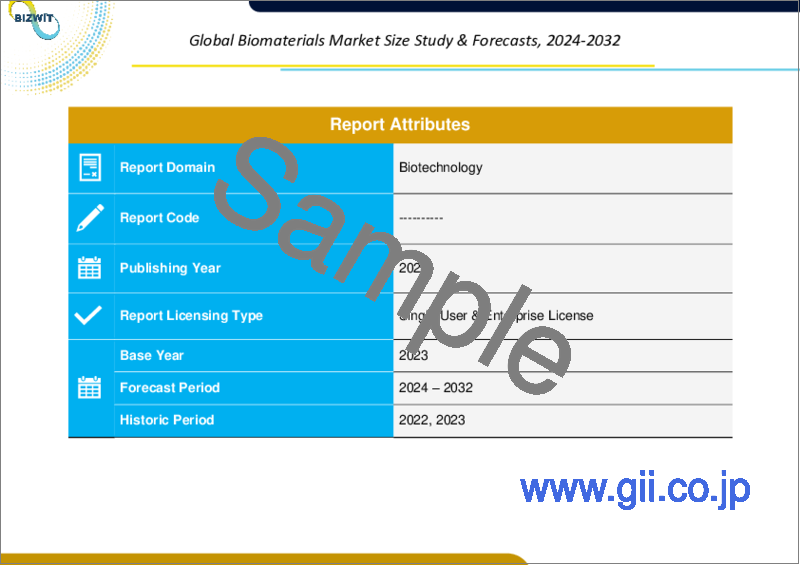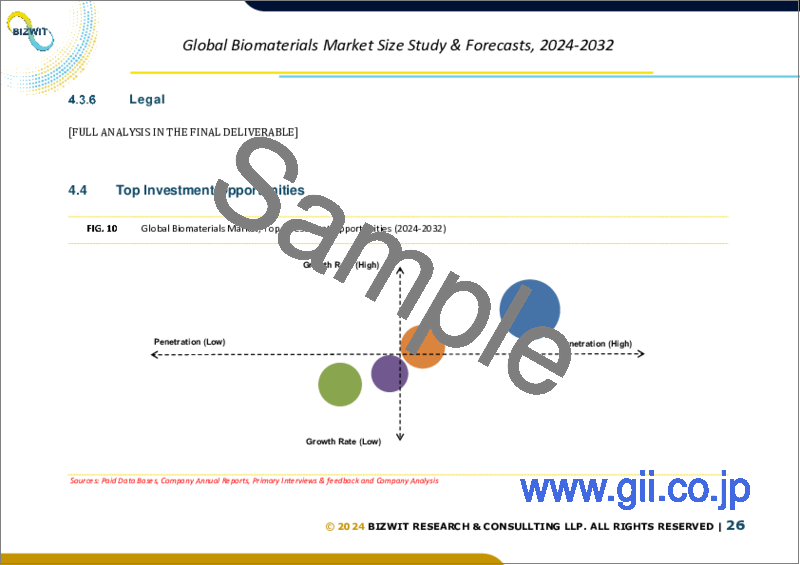|
|
市場調査レポート
商品コード
1534164
バイオマテリアルの世界市場規模調査:製品別、用途別、地域別予測、2022年~2032年Global Biomaterials Market Size Study, by Product, by Application and Regional Forecasts 2022-2032 |
||||||
カスタマイズ可能
|
|||||||
| バイオマテリアルの世界市場規模調査:製品別、用途別、地域別予測、2022年~2032年 |
|
出版日: 2024年08月10日
発行: Bizwit Research & Consulting LLP
ページ情報: 英文 285 Pages
納期: 2~3営業日
|
全表示
- 概要
- 目次
世界のバイオマテリアル市場は、2023年に約1,780億米ドルと評価され、予測期間2024-2032年には15.6%以上の健全な成長率で成長すると予測されています。
バイオマテリアルは、インプラント、人工装具、ドラッグデリバリーシステムなど、医療目的で生体システムと相互作用するように設計された物質です。これらの材料は生体組織と適合するように設計されており、特定の機械的、化学的、生物学的特性を持ちながら治癒と再生を促進します。バイオマテリアルは様々な医療用途で極めて重要な役割を果たしており、ヘルスケアの進歩を促進し、患者の転帰を改善しています。筋骨格系や慢性骨格系の病状が増加していることから、バイオマテリアルをベースとしたインプラントの需要が刺激され、市場の拡大が期待されています。変形性関節症や退行性疾患などの慢性疾患の有病率の増加は、高度なバイオマテリアルへの需要を高めています。関節置換術や関節補強術は、こうした状態による可動性の制限や痛みに直面している人々にとって不可欠な治療法となっています。金属バイオマテリアルは、身体と一体化し、機能性を回復させ、罹患者の生活の質を向上させる、耐久性があり長持ちするソリューションを提供することで、このニーズに対応しています。
技術の進歩は、バイオマテリアルを絶えず改良し、特定の医療要件を満たすように調整します。技術革新は、生体適合性、耐食性、生体システムとシームレスに統合する能力の向上に焦点を当てています。この進化により、身体のバイオメカニクスに耐えるだけでなく、治癒と統合を促進し、移植後の合併症のリスクを低減するインプラントの創造が可能になった。加えて、世界人口の高齢化もバイオマテリアルの需要に大きく寄与しています。人口の高齢化に伴い、慢性疾患や加齢に伴う傷害の有病率が上昇し、効果的で耐久性のある医療介入の必要性が高まっています。バイオマテリアルは、高齢化層特有のニーズに沿ったソリューションを提供することで、こうしたヘルスケアの課題に対処する上で重要な役割を果たしています。さらに、骨、歯、その他の臓器などの組織置換や修復への応用が拡大していることから、新規バイオマテリアルに対する需要は近年増加しています。
北米が2023年にバイオマテリアル市場全体を支配したのは、米国科学財団や米国標準技術研究所を含む様々な公的機関や民間機関が、生体医学用途でのバイオマテリアルの利用に関する専門知識や支援を提供するイニシアティブを取ったためです。このため、この地域ではバイオマテリアルの採用が増加しています。加えて、有利な政府政策とこの分野における多数の大手市場プレイヤーの集中が、この地域の市場シェアに大きく貢献しています。アジア太平洋地域は、予測期間中に最も速いCAGRで成長すると予想されます。これは、地域参入企業が地域市場と世界市場の両方における地位を強化するために戦略的イニシアチブを実施しているためです。
目次
第1章 バイオマテリアルの世界市場エグゼクティブサマリー
- バイオマテリアルの世界市場規模・予測(2022-2032年)
- 地域別概要
- セグメント別概要
- 製品別
- 用途別
- 主要動向
- 景気後退の影響
- アナリストの結論・提言
第2章 世界のバイオマテリアル市場の定義と調査前提条件
- 調査目的
- 市場の定義
- 調査前提条件
- 包含と除外
- 制限事項
- 供給サイドの分析
- 入手可能性
- インフラ
- 規制環境
- 市場競争
- 経済性(消費者の視点)
- 需要サイド分析
- 規制の枠組み
- 技術の進歩
- 環境への配慮
- 消費者の意識と受容
- 調査手法
- 調査対象年
- 通貨換算レート
第3章 バイオマテリアルの世界市場力学
- 市場促進要因
- 筋骨格系および慢性骨格系疾患の増加
- バイオマテリアルの技術的進歩
- 世界人口の高齢化
- 市場の課題
- 厳しい規制承認
- 先端バイオマテリアルの高コスト
- 市場機会
- 新規バイオマテリアルの研究開発の増加
- 組織工学と修復における用途の拡大
第4章 世界のバイオマテリアル市場産業分析
- ポーターのファイブフォースモデル
- 供給企業の交渉力
- 買い手の交渉力
- 新規参入業者の脅威
- 代替品の脅威
- 競争企業間の敵対関係
- ポーターのファイブフォースモデルへの未来的アプローチ
- ポーターのファイブフォースの影響分析
- PESTEL分析
- 政治
- 経済
- 社会
- 技術
- 環境
- 法律
- 主な投資機会
- 主要成功戦略
- 破壊的動向
- 業界専門家の視点
- アナリストの結論・提言
第5章 バイオマテリアルの世界市場規模と予測:製品別、2022年~2032年
- セグメントダッシュボード
- バイオマテリアルの世界市場:収益動向分析、2022年・2032年
- 金属
- 天然
- セラミックス
- ポリマー
第6章 バイオマテリアルの世界市場規模と予測:用途別、2022年~2032年
- セグメントダッシュボード
- バイオマテリアルの世界市場:収益動向分析、2022年・2032年
- 心臓血管
- 眼科
- 歯科
- 整形外科
- 創傷治癒
- 組織工学
- 形成外科
- 神経学
- その他
第7章 バイオマテリアルの世界市場規模と予測:地域別、2022年~2032年
- 北米
- 米国
- カナダ
- 欧州
- 英国
- ドイツ
- フランス
- スペイン
- イタリア
- その他欧州
- アジア太平洋
- 中国
- インド
- 日本
- オーストラリア
- 韓国
- その他アジア太平洋地域
- ラテンアメリカ
- ブラジル
- メキシコ
- その他ラテンアメリカ
- 中東・アフリカ
- サウジアラビア
- 南アフリカ
- その他中東とアフリカ
第8章 競合情報
- 主要企業のSWOT分析
- 主要市場戦略
- 企業プロファイル
- Medtronic
- 主要情報
- 概要
- 財務(データの入手可能性によります)
- 製品概要
- 市場戦略
- Evonik Industries AG
- Carpenter Technology Corporation
- Berkeley Advanced Biomaterials
- Invibio Ltd.
- Zimmer Biomet Holdings, Inc.
- BASF SE
- Covalon Technologies Ltd.
- Stryker
- Johnson & Johnson
- Dentsply Sirona
- CoorsTek Inc.
- Corbion
- Regenity Biosciences
- Covalon Technologies Ltd.
- Medtronic
第9章 調査プロセス
- 調査プロセス
- データマイニング
- 分析
- 市場推定
- 検証
- 出版
- 調査属性
The Global Biomaterials Market is valued at approximately USD 178.0 billion in 2023 and is anticipated to grow with a healthy growth rate of more than 15.6% over the forecast period 2024-2032. Biomaterials are substances engineered to interact with biological systems for medical purposes, such as implants, prosthetics, and drug delivery systems. These materials are designed to be compatible with living tissues, promoting healing and regeneration while possessing specific mechanical, chemical, and biological properties. Biomaterials play a pivotal role in various medical applications, facilitating advancements in healthcare and improving patient outcomes. The growing incidence of musculoskeletal and chronic skeletal medical conditions is expected to stimulate the demand for implants based on biomaterials, thereby enhancing market expansion. The increasing prevalence of chronic conditions such as osteoarthritis and degenerative diseases intensifies the demand for advanced biomaterials. Joint replacements and augmentations become essential interventions for individuals facing limited mobility and pain due to these conditions. Metallic biomaterials address this need by offering durable and long-lasting solutions that integrate with the body, restoring functionality and enhancing the quality of life for affected individuals.
Technological advancements continually refine biomaterials, tailoring them to meet specific medical requirements. Innovations focus on improving biocompatibility, corrosion resistance, and the ability to integrate seamlessly with biological systems. This evolution enables the creation of implants that not only withstand the body's biomechanics but also promote healing and integration, reducing the risk of complications post-implantation. In addition, the aging global population contributes significantly to the demand for biomaterials. As the population ages, the prevalence of chronic conditions and age-related injuries rises, amplifying the necessity for effective and durable medical interventions. Biomaterials play a crucial role in addressing these healthcare challenges by offering solutions that align with the unique needs of an aging demographic. Furthermore, the demand for novel biomaterials has been increasing in recent years owing to their growing application in tissue replacement and repair, such as bones, teeth, and other organs.
North America dominated the overall biomaterials market in 2023 due to the initiatives by various public and private organizations, including the National Science Foundation and the National Institute of Standards and Technology, offering expertise and support regarding the utilization of biomaterials in biomedical applications. This has led to increased adoption of biomaterials in the region. Additionally, favourable government policies and the concentration of numerous major market players in this area have significantly contributed to the regional market share. The Asia Pacific region is expected to grow at the fastest CAGR during the forecast period due to the strategic initiatives implemented by regional participants to strengthen their position in both local and global markets.
Major market players included in this report are:
- Medtronic
- Evonik Industries AG
- Carpenter Technology Corporation
- Berkeley Advanced Biomaterials
- Invibio Ltd.
- Zimmer Biomet Holdings, Inc.
- BASF SE
- Covalon Technologies Ltd.
- Stryker
- Johnson & Johnson
- Dentsply Sirona
- CoorsTek Inc.
- Corbion
- Regenity Biosciences
- Covalon Technologies Ltd.
The detailed segments and sub-segment of the market are explained below:
By Product:
- Metallic
- Natural
- Ceramics
- Polymers
By Application:
- Cardiovascular
- Ophthalmology
- Dental
- Orthopedic
- Wound Healing
- Tissue Engineering
- Plastic Surgery
- Neurology
- Others
By Region:
- North America
- U.S.
- Canada
- Europe
- UK
- Germany
- France
- Spain
- Italy
- ROE
- Asia Pacific
- China
- India
- Japan
- Australia
- South Korea
- RoAPAC
- Latin America
- Brazil
- Mexico
- RoLA
- Middle East & Africa
- Saudi Arabia
- South Africa
- RoMEA
Years considered for the study are as follows:
- Historical year - 2022
- Base year - 2023
- Forecast period - 2024 to 2032
Key Takeaways:
- Market Estimates & Forecast for 10 years from 2022 to 2032.
- Annualized revenues and regional level analysis for each market segment.
- Detailed analysis of geographical landscape with Country level analysis of major regions.
- Competitive landscape with information on major players in the market.
- Analysis of key business strategies and recommendations on future market approach.
- Analysis of competitive structure of the market.
- Demand side and supply side analysis of the market.
Table of Contents
Chapter 1. Global Biomaterials Market Executive Summary
- 1.1. Global Biomaterials Market Size & Forecast (2022-2032)
- 1.2. Regional Summary
- 1.3. Segmental Summary
- 1.3.1. By Product
- 1.3.2. By Application
- 1.4. Key Trends
- 1.5. Recession Impact
- 1.6. Analyst Recommendation & Conclusion
Chapter 2. Global Biomaterials Market Definition and Research Assumptions
- 2.1. Research Objective
- 2.2. Market Definition
- 2.3. Research Assumptions
- 2.3.1. Inclusion & Exclusion
- 2.3.2. Limitations
- 2.3.3. Supply Side Analysis
- 2.3.3.1. Availability
- 2.3.3.2. Infrastructure
- 2.3.3.3. Regulatory Environment
- 2.3.3.4. Market Competition
- 2.3.3.5. Economic Viability (Consumer's Perspective)
- 2.3.4. Demand Side Analysis
- 2.3.4.1. Regulatory frameworks
- 2.3.4.2. Technological Advancements
- 2.3.4.3. Environmental Considerations
- 2.3.4.4. Consumer Awareness & Acceptance
- 2.4. Estimation Methodology
- 2.5. Years Considered for the Study
- 2.6. Currency Conversion Rates
Chapter 3. Global Biomaterials Market Dynamics
- 3.1. Market Drivers
- 3.1.1. Rising incidence of musculoskeletal and chronic skeletal conditions
- 3.1.2. Technological advancements in biomaterials
- 3.1.3. Aging global population
- 3.2. Market Challenges
- 3.2.1. Stringent regulatory approvals
- 3.2.2. High cost of advanced biomaterials
- 3.3. Market Opportunities
- 3.3.1. Increased R&D for novel biomaterials
- 3.3.2. Growing applications in tissue engineering and repair
Chapter 4. Global Biomaterials Market Industry Analysis
- 4.1. Porter's 5 Force Model
- 4.1.1. Bargaining Power of Suppliers
- 4.1.2. Bargaining Power of Buyers
- 4.1.3. Threat of New Entrants
- 4.1.4. Threat of Substitutes
- 4.1.5. Competitive Rivalry
- 4.1.6. Futuristic Approach to Porter's 5 Force Model
- 4.1.7. Porter's 5 Force Impact Analysis
- 4.2. PESTEL Analysis
- 4.2.1. Political
- 4.2.2. Economical
- 4.2.3. Social
- 4.2.4. Technological
- 4.2.5. Environmental
- 4.2.6. Legal
- 4.3. Top investment opportunity
- 4.4. Top winning strategies
- 4.5. Disruptive Trends
- 4.6. Industry Expert Perspective
- 4.7. Analyst Recommendation & Conclusion
Chapter 5. Global Biomaterials Market Size & Forecasts by Product 2022-2032
- 5.1. Segment Dashboard
- 5.2. Global Biomaterials Market: Product Revenue Trend Analysis, 2022 & 2032 (USD Billion)
- 5.2.1. Metallic
- 5.2.2. Natural
- 5.2.3. Ceramics
- 5.2.4. Polymers
Chapter 6. Global Biomaterials Market Size & Forecasts by Application 2022-2032
- 6.1. Segment Dashboard
- 6.2. Global Biomaterials Market: Application Revenue Trend Analysis, 2022 & 2032 (USD Billion)
- 6.2.1. Cardiovascular
- 6.2.2. Ophthalmology
- 6.2.3. Dental
- 6.2.4. Orthopedic
- 6.2.5. Wound Healing
- 6.2.6. Tissue Engineering
- 6.2.7. Plastic Surgery
- 6.2.8. Neurology
- 6.2.9. Others
Chapter 7. Global Biomaterials Market Size & Forecasts by Region 2022-2032
- 7.1. North America Biomaterials Market
- 7.1.1. U.S. Biomaterials Market
- 7.1.1.1. Product breakdown size & forecasts, 2022-2032
- 7.1.1.2. Application breakdown size & forecasts, 2022-2032
- 7.1.2. Canada Biomaterials Market
- 7.1.1. U.S. Biomaterials Market
- 7.2. Europe Biomaterials Market
- 7.2.1. U.K. Biomaterials Market
- 7.2.2. Germany Biomaterials Market
- 7.2.3. France Biomaterials Market
- 7.2.4. Spain Biomaterials Market
- 7.2.5. Italy Biomaterials Market
- 7.2.6. Rest of Europe Biomaterials Market
- 7.3. Asia-Pacific Biomaterials Market
- 7.3.1. China Biomaterials Market
- 7.3.2. India Biomaterials Market
- 7.3.3. Japan Biomaterials Market
- 7.3.4. Australia Biomaterials Market
- 7.3.5. South Korea Biomaterials Market
- 7.3.6. Rest of Asia Pacific Biomaterials Market
- 7.4. Latin America Biomaterials Market
- 7.4.1. Brazil Biomaterials Market
- 7.4.2. Mexico Biomaterials Market
- 7.4.3. Rest of Latin America Biomaterials Market
- 7.5. Middle East & Africa Biomaterials Market
- 7.5.1. Saudi Arabia Biomaterials Market
- 7.5.2. South Africa Biomaterials Market
- 7.5.3. Rest of Middle East & Africa Biomaterials Market
Chapter 8. Competitive Intelligence
- 8.1. Key Company SWOT Analysis
- 8.2. Top Market Strategies
- 8.3. Company Profiles
- 8.3.1. Medtronic
- 8.3.1.1. Key Information
- 8.3.1.2. Overview
- 8.3.1.3. Financial (Subject to Data Availability)
- 8.3.1.4. Product Summary
- 8.3.1.5. Market Strategies
- 8.3.2. Evonik Industries AG
- 8.3.3. Carpenter Technology Corporation
- 8.3.4. Berkeley Advanced Biomaterials
- 8.3.5. Invibio Ltd.
- 8.3.6. Zimmer Biomet Holdings, Inc.
- 8.3.7. BASF SE
- 8.3.8. Covalon Technologies Ltd.
- 8.3.9. Stryker
- 8.3.10. Johnson & Johnson
- 8.3.11. Dentsply Sirona
- 8.3.12. CoorsTek Inc.
- 8.3.13. Corbion
- 8.3.14. Regenity Biosciences
- 8.3.15. Covalon Technologies Ltd.
- 8.3.1. Medtronic
Chapter 9. Research Process
- 9.1. Research Process
- 9.1.1. Data Mining
- 9.1.2. Analysis
- 9.1.3. Market Estimation
- 9.1.4. Validation
- 9.1.5. Publishing
- 9.2. Research Attributes






